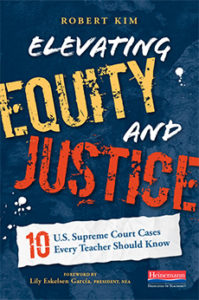Using Supreme Court Cases to Teach Equity
Elevating Equity and Justice: 10 U.S. Supreme Court Cases Every Teacher Should Know
By Robert Kim
(Heinemann, 2019 – Learn more)

In Elevating Equity and Justice, education law expert Robert Kim is detailed and practical in his approach. His focused summary and analysis of 10 intrinsically important Supreme Court cases are applicable to every educator, ultimately proving the book a valuable resource for teachers everywhere.

In addition to his analysis, Kim includes personal testimonies and suggestions from other educators and offers a reflection question within the chapter which acts as an excellent guide for the reader to process the information.
I especially appreciated the way Kim systematically broke down each case. Because I have used full-text Supreme Court cases in academic work before, I welcomed the reader-friendly format Kim employed. He expertly synthesized the information which allowed me to easily glean important tips that I can utilize as a future classroom teacher.
Applying cases to public schools
The specific portions of Kim’s book that I found the most helpful were his Implications and Getting Proactive sections. These portions were the perfect touch because they really solidified the practical focus of his book. In the Implications section, I loved how the bullet points provided succinct and detailed information concerning how each specific case applies to everyday life in public schools.
In that same vein, the Getting Proactive section allowed me to recognize tangible actions I can take to teach my future elementary school students about the law and how it applies to them. Furthermore, I can make connections to how the law functions in my specific place of work.
Conversation rather than legal jargon
I also appreciated the conversational presentation of the facts Kim included at the beginning of each chapter. Rather than following a typical lawyerly and ultimately dry outlining of the situation, Kim relayed the information as if he were telling a story. I found this especially helpful because it allowed me to easily take in and remember the context surrounding the case as I read through the rest of the chapter.
I was especially impressed with this portion because I know it would have been easy to present legal jargon in a dry manner. Rather than risk losing the reader’s attention, Kim put in the extra effort to ensure that his descriptions were interesting and attention-grabbing, empowering the reader through his accessible language. This portion in particular was masterfully done and is ultimately a resource that I think is valuable for both school leaders and classroom teachers.
In summary, I really enjoyed Elevating Equity and Justice. The information in this book is important because it offers educators something extremely valuable: new knowledge. As classroom teachers who are affected by the Supreme Court decisions Kim discusses, it is vital that we have the insights necessary to understand and utilize the law to our benefit. Kim’s user-friendly discussion of the education law elevating equity and justice should be on every teacher’s resource bookshelf.
Morgan DeVico is studying English Education at Pepperdine University with the hope of becoming a high school English teacher. She lives in Camarillo, California, with her four dogs and spends her free time crocheting and doing Pilates. In the future, Morgan hopes to travel the world and to start her own tutoring company.

































